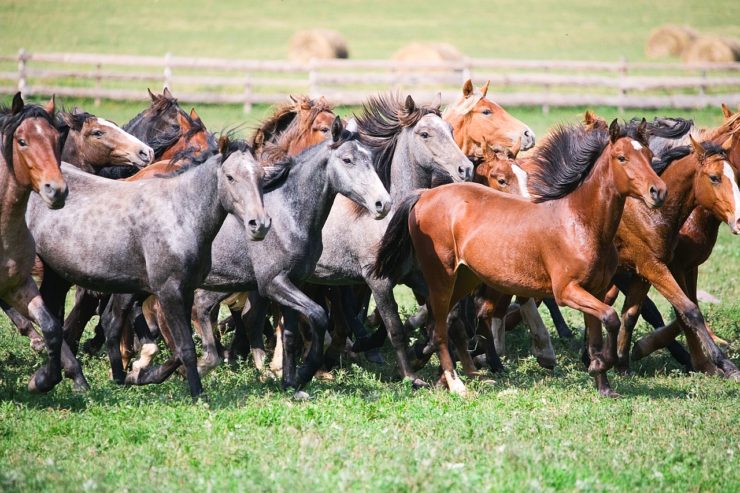Horses are creatures of habit. This is received wisdom, and true wisdom. Teach a horse something once, he’ll remember it. Teach it to him twice, it’s set in stone. And if it’s something inadvertent, backwards, or outright counterproductive, he’ll really never forget. It takes many times longer to undo it than it did to do it in the first place.
Horse memory is a remarkable phenomenon. Their long-term memory is at least as good as, and may be more accurate, than a human’s. This study blew a few scientific minds, though the anecdotal evidence has been demonstrating for years that once a horse gets an idea in his head, it stays there. He’ll also extrapolate from that idea to similar situations, and respond accordingly.
Not bad for an animal with a brain the size of your fist.
Any animal (humans included) may want to eat at the same time every day, and may want to eat the same thing at this time, too. They’ll want to wear their hair a certain way, go to work by a certain route, do certain kinds of things on their days off. For a horse, routine is of crucial importance. Horses do not like change. Change, to a horse’s way of thinking, is bad.
Horses are profound physical conservatives. They want their herd around them, with the same horses in it, and the same daily routines: eating, drinking, playing, mutual grooming, and in a domesticated setting, interaction with humans. If they’re in the wild or in a large turnout area, they’ll move around in predictable patterns, from the grazing areas to the water hole or tank to the napping spots.
Observe a herd of horses over a period of time and you start to realize how bound they are by routine. They’ll eat at particular times, and have particular napping times and durations. They’ll be more active in cooler weather and more sluggish when it’s warm, but the timing of that activity can be pretty consistent: usually at the beginning or end of the day, and if they’re domesticated, around mealtimes. From midmorning to midafternoon, they’ll take turns eating and napping.
Nighttime is much the same. Horses are awake as much as 21 hours a day. At night they’ll be more inclined to clump together in a herd, and may be more likely to lie down to sleep; if mares are pregnant, this is when they like to foal, when the major predators are sleeping themselves. They’ll graze, because that much herbivore needs to eat fairly constantly.
Buy the Book


Burning Roses
All this routine has an evolutionary purpose. Routine is safe–it’s predictable. It helps the herd to function as a unit. Its members know what they’re doing and when, and while some are eating or sleeping, others are watching out for predators.
The drawback is that when the routine is disrupted, the horse can fall apart. But that makes sense in terms of survival, too. A horse who falls apart will run away from whatever set him off–and running is his best defense against danger.
In a domesticated setting, this can be a problem. One thing horse trainers work hard at is, first, making sure the horse learns good or useful habits and not bad or dangerous ones (letting a rider on his back versus rearing up and throwing himself over backwards–the latter makes sense with a lion on your back, but not so much when it’s a monkey in a saddle), and second, teaching the horse to accept new or previously unknown input without (sometimes literally) flipping out. They do this by introducing a lot of different stimuli in ways that demonstrate that those stimuli will not eat the horse, and also by teaching the horse that the trainer, and by extension humans in general, is to be trusted.
Trust is a big deal in the horse world. Horses are wired to follow the leader. If the leader leads the herd into a pack of wolves, the herd stops trusting her. Likewise, if she leads them to the good grazing and the sweet water, that’s good. She’s the leader they’ll follow. There is volition in this–horses aren’t blind creatures of instinct; they process data, they learn, they act on what they learn. They can make choices, but those choices will be based on what is most safe and most comfortable for the individual and the herd.
When a human gets into the mix, the horse may find himself being asked to do things that run counter to instinct, such as running across country with (and not as the main item on the dinner menu for) a pack of dogs, carrying a cavalryman into battle (with sharp nasty weapons and, in later eras, loud explosions), or–and for a horse this is just as bad–walking into a box hardly larger than himself, into which he will be locked for long periods without possibility of escape.
It says a great deal for a horse’s capacity to learn, and also for his capacity for trust, that he not only accepts these things, he may embrace them. He learns to love running with the hounds, he takes bullets and bombs in stride, and he finds security in the confinement of a stall. These become habits, and once a horse forms a habit, it takes an awful lot to shake him loose.
Judith Tarr’s first novel, The Isle of Glass, appeared in 1985. Since then she’s written novels and shorter works of historical fiction and historical fantasy and epic fantasy and space opera and contemporary fantasy, many of which have been reborn as ebooks. She has even written a primer for writers: Writing Horses: The Fine Art of Getting It Right. She has won the Crawford Award, and been a finalist for the World Fantasy Award and the Locus Award. She lives in Arizona with an assortment of cats, a blue-eyed dog, and a herd of Lipizzan horses.










